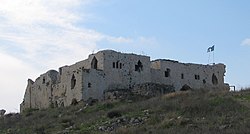Majdal Yaba
| Majdal Yaba | |
|---|---|

The Majdal Tower Fortress on the former site of Majdal Yaba, 2008
|
|
| Arabic | مجدل يابا |
| Name meaning | "Tower of [our] Father" or "Tower of Yafa" and later "Tower of Sadiq" or "The watch-tower of Yâba" |
| Also spelled | Majdal al-Sadiq, Majdal Yafa |
| Subdistrict | Ramle |
| Coordinates | 32°04′51.04″N 34°57′24.97″E / 32.0808444°N 34.9569361°ECoordinates: 32°04′51.04″N 34°57′24.97″E / 32.0808444°N 34.9569361°E |
| Palestine grid | 146/165 |
| Population | 1,520 (1945) |
| Area | 26,332 dunams 26.3 km² |
| Date of depopulation | July 10, 1948 |
| Cause(s) of depopulation | Military assault by Yishuv forces |
| Current localities | Rosh HaAyin, Givat HaShlosha, Nahshonim,Migdal Afek |
Majdal Yaba (Arabic: مجدل يابا) was a Palestinian Arab village in the Ramle Subdistrict, located 18.5 kilometres (11.5 mi) northeast of Ramla and 4 kilometres (2.5 mi) east of Jaffa. A walled city stood at the same site as early as 3000 BCE, and Majdal Yaba is first mentioned by the name Aphek in Egyptian Execration texts dating to the 19th century BCE. In the Bible's Old Testament, Aphek is described as a city conquered from the Canaanites by the Israelites, who then lost it to the Philistines. It is also mentioned in extrabiblical Babylonian and Assyrian texts as a Philistine stronghold. Under Roman rule, the city was known as Antipatris and the Crusaders, who built a fort there, renamed it Mirabel. During the Islamic period it became known as Majdal Yaba. For a short time under Ottoman rule, its name was changed from Majdal Yaba to Majdal Sadiq and then back again.
Incorporated into Mandatory Palestine in 1922, Majdal Yaba was captured by Israeli forces during the 1948 Arab–Israeli war on July 12, 1948. The town was depopulated as a result of the military assault. The number of refugees from Majdal Yaba was estimated at 1,763 in 1948, and they and their descendants were estimated to number over 10,000 in 1998. The Israeli locality of Rosh HaAyin was established on the village lands in 1950, followed by the kibbutz Givat HaShlosha in 1953.
...
Wikipedia

